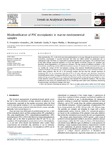Misidentification of PVC Microplastics in Marine Environmental Samples

Use this link to cite
http://hdl.handle.net/2183/31562Collections
- Investigación (FCIE) [1227]
Metadata
Show full item recordTitle
Misidentification of PVC Microplastics in Marine Environmental SamplesDate
2022-04-30Citation
V. Fernández-González, J.M. Andrade-Garda, P. López-Mahía, S. Muniategui-Lorenzo, Misidentification of PVC microplastics in marine environmental samples, TrAC Trends in Analytical Chemistry. 153 (2022) 116649. https://doi.org/10.1016/j.trac.2022.116649.
Abstract
[Abstract] Poly(vinylchloride), PVC, is the third most demanded polymer in Europe although its presence in marine ecosystems, surprisingly, is scarcely observed. This does not reflect neither its production nor its widespread usage. Therefore, it is imperative to understand why this may happen. PVC is the least stable of the high-tonnage produced polymers as it has the highest sensitivity towards UV radiation and, therefore, photo-degradation is of maximum relevance. The big amount of additives included in PVC formulations, weathering and the different treatments required to isolate it from environmental samples can modify the surface of PVC microplastics, making their spectral identification/quantification an analytical challenge. All these factors can lead to large PVC underestimations in environmental studies, in which other polymers like PE, PP or PS outstand. Further, the fact that the infrared spectrum of weathered PVC can be confounded with that of PE is of most relevance and, therefore, remarkable misidentifications and/or wrong quantifications may occur. In this work some relevant factors that can explain the low percentages of PVC reported in the literature are discussed and special emphasis is made on the need for suitable spectroscopic databases that include PVC weathered standards. This has been confirmed by the results of a detailed study of PVC weathering under pilot-scale conditions, monitoring its spectroscopic and physical changes over time.
Keywords
PVC
Polymer misidentification
Infrared spectrometry
Microplastics weathering
Polymer misidentification
Infrared spectrometry
Microplastics weathering
Description
Financiado para publicación en acceso aberto: Universidade da Coruña/CISUG
Editor version
Rights
Atribución 4.0 Internacional
ISSN
0165-9936






